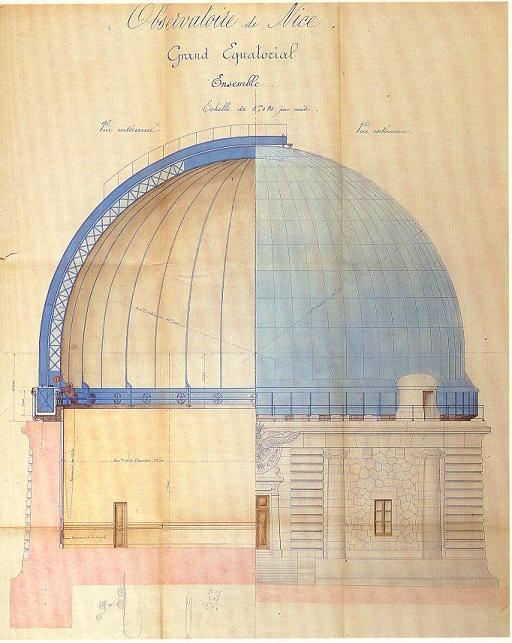I) The dome of the
observatory of Nice
In 1884, interested by the creative qualities of the manufacturer of Levallois-Perret, patron-banker Bichoffshein asked
Gustave Eiffel to design the dome of the observatory of Nice, but Eiffel was not
the only applicant. How did he win agreement?

First
of all, on May 21st, 1881,
specifications were sent to twenty builders: seven
projects were deposited. Gustave Eiffelís project, considered too innovative,
was classified only second; it however held the attention of the Admiral
Blow and of the architect Garnier, who rebelled against the decision of the
Committee. The controversy got worse and on the Admiral mouchezís initiative
the community of observatory pronounces, on the February 10th, 1883, for Gustave
Eiffel's project. The latter has assured the functioning of this dome during
ten years.
Bichoffshein,
financier, owner and maitre of works, chose Garnier as architect and,so,give
to Gustave Eiffel, the building of the" big equatorial " of 16
metres tall and his dome. So Garnier,for reassure the worried, reintroduced
in the project of Eiffel the ball bearingís process, by keeping the annular
ballcock. Indeed this solution give an alternative of help in case of breakdown.Gustave
Eiffel's system was attractive but actually raised two problems: the first one
concerned the staircase of observation, on which the astronomer would stand:
it must be able to move everywhere on the floor along with the dome. Staircase
and dome, indeed, had to be bound together. The second problem was the weight of the dome: 162
tons had to be relieved but it was also necessary to avoid the risk of deformation;
Eiffel, consequently, got rid of the frictions between mechanical parts by making the
dome float on the annular tub. Naturally, this tub is filled with an appropriate
liquid, potasium carbonate; therefore, the lower ring of the dome once stiffened,
got indeformable; the base was not sensitive to possible collapses in the wall
because it was liquid. Eiffel also found another way of relieving the dome by
building it out of steel.
The movement of rotation of this dome is made by a crank, but it can
also be operated by a clock machinery which offered the advantage of operating
a round in five minutes. The staircase of observation was articulated on a platform
which rose on pebbles, which enabled it to revolve in a circle of 9 metres
in diameter around the dome. In five minutes, the staircase rose from the ground
up to the summit. The opening system amazed comtemporaries by its modernism:
two doors ,placed along the height of the dome moved of 1.50 metres
apart, opening a free space of 3 metres in width, in the dome.
GASCARD simon

